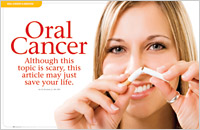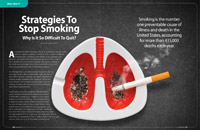Even though oral cancer may not get that much attention, as other more widely-known types of cancer, that doesn’t mean that is it any less deadly. Did you know that in the United States, oral cancer kills one person every hour? While it consists of a small percentage of all cancers, oral cancer is just as dangerous because it’s not usually detected until it reaches it’s most advanced stage. At that point, the odds aren’t that great, only 60% will survive after five years of treatment.

 A thorough examination for oral cancer should be part of your routine dental checkup — another reason to have a regular exams scheduled. When screening for oral cancer it should include a visual assessment or your lips, tongue, and the inside of your mouth, including to check for white or red patches or unusual sores in your mouth. The inside of your mouth may be pressed with fingers to detect if there is presence of any lumps and swelling, and your tongue may also be pulled aside to better view the sides. A special dye or any other procedures may also be used to help in checking for oral cancer. If there is anything out of the ordinary, a biopsy can easily be performed.
If you notice any color changes or abnormal sores in your mouth, around lips or tongue, this may be signs of oral cancer. Sores or other unusual changes that haven’t gone away after 2-3 weeks should be examined by your family dentist. Remember that the only accurate diagnosis of oral cancer is through a lab report. Early detection along with thorough exams regularly at your dental checkups is one of the best ways to fight against oral cancer.
A thorough examination for oral cancer should be part of your routine dental checkup — another reason to have a regular exams scheduled. When screening for oral cancer it should include a visual assessment or your lips, tongue, and the inside of your mouth, including to check for white or red patches or unusual sores in your mouth. The inside of your mouth may be pressed with fingers to detect if there is presence of any lumps and swelling, and your tongue may also be pulled aside to better view the sides. A special dye or any other procedures may also be used to help in checking for oral cancer. If there is anything out of the ordinary, a biopsy can easily be performed.
If you notice any color changes or abnormal sores in your mouth, around lips or tongue, this may be signs of oral cancer. Sores or other unusual changes that haven’t gone away after 2-3 weeks should be examined by your family dentist. Remember that the only accurate diagnosis of oral cancer is through a lab report. Early detection along with thorough exams regularly at your dental checkups is one of the best ways to fight against oral cancer.
 Oral Cancer This article may just save your life. Learn how to notice any unusual lesions (sores or ulcers) anywhere in your mouth that do not heal within two-three weeks. Early detection is key... Read Article
Oral Cancer This article may just save your life. Learn how to notice any unusual lesions (sores or ulcers) anywhere in your mouth that do not heal within two-three weeks. Early detection is key... Read Article
 Strategies To Stop Smoking Cigarette smoking is the number one preventable cause of illness and death. Quitting smoking could prevent a large number of diseases and deaths each year. Many smokers find it difficult to stop, a fact that is confirmed by the staggering rate of relapse. Given the fact that cigarette smoking is a learned behavior that is reinforced over time, it makes sense that to be successful in quitting, you must “unlearn” this behavior. Here are some suggested ways to learn how... Read Article
Strategies To Stop Smoking Cigarette smoking is the number one preventable cause of illness and death. Quitting smoking could prevent a large number of diseases and deaths each year. Many smokers find it difficult to stop, a fact that is confirmed by the staggering rate of relapse. Given the fact that cigarette smoking is a learned behavior that is reinforced over time, it makes sense that to be successful in quitting, you must “unlearn” this behavior. Here are some suggested ways to learn how... Read Article

Oral Cancer Screenings
Would you take a simple test if it could give you the early warning about you possibly having oral cancer? The good news is — there is such a test! Early detection has increased the survival rate of oral cancer to 80% or better, this test can truly saves lives. Having an oral cancer screening as part of your routine dental checkup is something you should already be doing. The exam for oral cancer is fast and painless. the goal is to identify any small changes in the lining tissues of your mouth, lips, and tongue that may help to detect the early sages of oral cancer. The screening is usually a visual and tactile (touch) exam. If there are any abnormalities noted, a small piece of tissue can be used as a sample for further testing in a laboratory.Who’s At Risk for Developing Oral Cancer?
The answer may be very surprising. It used to be thought of as a disease only for an older person, and usually affects those over 40. But today, more younger people are forming the fastest growing segment among all oral cancer patients. Oral cancer is mainly caused by the spread of a sexually-transmitted disease known as the Human Papilloma Virus (HPV16). But the other major risk factors also do apply: middle aged or older, a drinker - moderate to heavy or a long-term tobacco user, you have a greater risk of developing oral cancer. Chronic exposure to the sun, is also associated with lip cancer.Detecting Oral Cancer
 A thorough examination for oral cancer should be part of your routine dental checkup — another reason to have a regular exams scheduled. When screening for oral cancer it should include a visual assessment or your lips, tongue, and the inside of your mouth, including to check for white or red patches or unusual sores in your mouth. The inside of your mouth may be pressed with fingers to detect if there is presence of any lumps and swelling, and your tongue may also be pulled aside to better view the sides. A special dye or any other procedures may also be used to help in checking for oral cancer. If there is anything out of the ordinary, a biopsy can easily be performed.
If you notice any color changes or abnormal sores in your mouth, around lips or tongue, this may be signs of oral cancer. Sores or other unusual changes that haven’t gone away after 2-3 weeks should be examined by your family dentist. Remember that the only accurate diagnosis of oral cancer is through a lab report. Early detection along with thorough exams regularly at your dental checkups is one of the best ways to fight against oral cancer.
A thorough examination for oral cancer should be part of your routine dental checkup — another reason to have a regular exams scheduled. When screening for oral cancer it should include a visual assessment or your lips, tongue, and the inside of your mouth, including to check for white or red patches or unusual sores in your mouth. The inside of your mouth may be pressed with fingers to detect if there is presence of any lumps and swelling, and your tongue may also be pulled aside to better view the sides. A special dye or any other procedures may also be used to help in checking for oral cancer. If there is anything out of the ordinary, a biopsy can easily be performed.
If you notice any color changes or abnormal sores in your mouth, around lips or tongue, this may be signs of oral cancer. Sores or other unusual changes that haven’t gone away after 2-3 weeks should be examined by your family dentist. Remember that the only accurate diagnosis of oral cancer is through a lab report. Early detection along with thorough exams regularly at your dental checkups is one of the best ways to fight against oral cancer.
Related Articles
 Oral Cancer This article may just save your life. Learn how to notice any unusual lesions (sores or ulcers) anywhere in your mouth that do not heal within two-three weeks. Early detection is key... Read Article
Oral Cancer This article may just save your life. Learn how to notice any unusual lesions (sores or ulcers) anywhere in your mouth that do not heal within two-three weeks. Early detection is key... Read Article
 Strategies To Stop Smoking Cigarette smoking is the number one preventable cause of illness and death. Quitting smoking could prevent a large number of diseases and deaths each year. Many smokers find it difficult to stop, a fact that is confirmed by the staggering rate of relapse. Given the fact that cigarette smoking is a learned behavior that is reinforced over time, it makes sense that to be successful in quitting, you must “unlearn” this behavior. Here are some suggested ways to learn how... Read Article
Strategies To Stop Smoking Cigarette smoking is the number one preventable cause of illness and death. Quitting smoking could prevent a large number of diseases and deaths each year. Many smokers find it difficult to stop, a fact that is confirmed by the staggering rate of relapse. Given the fact that cigarette smoking is a learned behavior that is reinforced over time, it makes sense that to be successful in quitting, you must “unlearn” this behavior. Here are some suggested ways to learn how... Read Article
